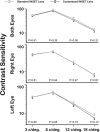Visual satisfaction with progressive addition lenses prescribed with novel foveal fixation axis measurements
- PMID: 37438410
- PMCID: PMC10338446
- DOI: 10.1038/s41598-023-38446-6
Visual satisfaction with progressive addition lenses prescribed with novel foveal fixation axis measurements
Abstract
Progressive addition lens (PAL) prescription is usually conducted using the pupillary centre as a reference, which in general does not coincide with the visual axis (kappa distance), and this difference could induce undesired prismatic effects in far and near vision distances and adaptation problems. This study aimed to assess the impact on subjects' visual satisfaction with PALs prescribed based on foveal fixation axis (FFA) measurements. Two different PALs (LifeStyle 3i, Hoya Lens Iberia) were randomly prescribed [one with a customized inset (the difference between the FFA measurements (Ergofocus®, Lentitech, Spain) at far and near distances and the second with a standard inset (2.5 mm)] to be used by 71 healthy presbyopic volunteers in a prospective double-masked crossover clinical study involving one month of use of each PAL. Patients were self-classified into four groups according to their previous experience with PALs: neophyte, PAL users, PAL drop-out, and uncomfortable PAL users. Visual function and overall satisfaction with each PAL were collected and compared. Ninety-seven percent (95% CI 93-100%) of participants successfully adapted to PALs prescribed with FFA without significant differences (P = 0.26) among the study groups (100% neophyte and uncomfortable PAL users (95% CI 100% in both groups), 89% (95% CI 67-100%) PAL users and 94% (95% CI 82-100%) PAL drop-out group). There were no statistically significant differences in visual function (P > 0.05) between customized and standard inset PALs. Customized and standard inset lenses showed similar satisfaction (P > 0.42) that increased significantly (P < 0.01 without any carry-over effect) after 30 days of wear. PALs prescribed with FFA measurements showed high visual satisfaction, suggesting that these measurements are suitable for prescribing PAL adaptation processes. Additional research is necessary to assess differences in PAL users' performance with different prescription methods and lens designs.
© 2023. The Author(s).
Conflict of interest statement
This study was supported by Lentitech Inc grant. O.G-E was supported by Junta Castilla y León (Consejería de Educación) Program: Grants to finance pre-doctoral recruitment research, cofunding by Social European Fund. The authors thank Hoya Lens Iberia S.L. for the supply of the LifeStyle 3i lenses and its collaboration in this study.
Figures






References
-
- Nations, U. World Population Ageing 2019. United Nations (2019).
-
- Boroyan HJ, et al. Lined multifocal wearers prefer progressive addition lenses. J. Am. Optom. Assoc. 1995;66:296–300. - PubMed
Publication types
MeSH terms
LinkOut - more resources
Full Text Sources

